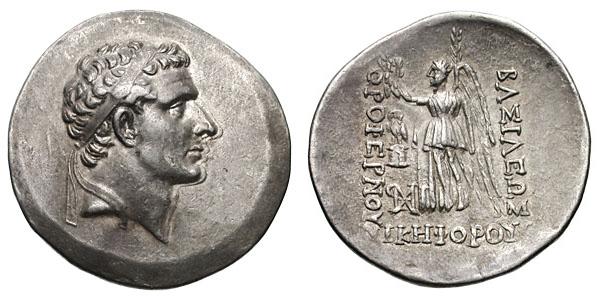S 1782 - Priene? (Orophernes), silver, tetradrachms (158-157 BCE)
From SILVER
158 BCE - 157 BCE Silver 754 kg
Description
| ObverseInscription or printing placed on the obverse.: | Diademed head to right |
| ReverseInscription or printing placed on the reverse.: | ΒΑΣΙΛΕΩΣ to right, ΟΡΟΦΕΡΝΟ[Υ] to left, [ΝΙΚΗΦΟΡΟΥ] in exergue (Greek).Nike standing to left, holding wreath and palm, to inner left, owl standing to left, head facing, on round altar, above monogram |
Mint and issuing power
| MintIdentifies the place of manufacture or issue of a numismatic object.: | Priene | Ancient regionAncient region.: | Ionia | Modern countryModern country: Turkey | AuthorityIdentifies the issuing power. The authority can be "pretended" when the name or the portrait of X is on the coin but he/she was not the issuing power. It can also be "uncertain" when there is no mention of X on the coin but he/she was the issuing power according to the historical sources: | Cappadocian kingdom |
Chronology
| FromIdentifies the initial date in a range assigned in a numismatic context. | 158 BCE | toIdentifies the final date in a range assigned in a numismatic context.. | 157 BCE | PeriodTime period of the numismatic object.: Hellenistic 323-30 BC |
Physical description
| MetalThe physical material (usually metal) from which an object is made.: | Silver |
Median weightMedian of the weights of numismatic objects (in grams). in grams | 16.60 | DenominationTerm indicating the value of a numismatic object. Examples: tetradrachm, chalkous, denarius.: | tetradrachm |
StandardStandard.: | Attic |
Image

S1782 Orophernes.jpg [1]
References
| Die study referencePublication of the study: | Salvesen 20001Salvesen 2000 | ||
| Coin series referenceReference to coin series study: | Sear II2Sear II, n° 7287, HGC 73HGC 7, n° 815 | ||
Obverse dies distribution
no distribution is available
Reverse dies distribution
no distribution is available
Quantification
| Number of obversesNumber of obverse dies. ᵖ (o) | 2 | Number of singletons (o1)The number of singleton coins. ᵖ | |
| Number of reverse diesNumber of reverse dies. (r) | Number of coinsNumber of coins. (n) | 9 | |
| Coins per obverse dieNumber of coins per obverse die. (n/o) | 4.5 | Coins per reverse dieNumber of coins per reverse die. (n/r) | |
| Reverse per obverse ratioRatio of obverse dies divided by reverse dies. (r/o) | Percentage of singletons (o1)number of coins (n) divided by the number of singletons (o1) ᵖ | % | |
| Original number of dies (O) (Carter 1983 formula)The estimation of the number of coins according to Carter 1983 ᵖ | 2.27 | Coins struck if 20,000 as average productivity per dieCoins made if the average productivity for obverses (according to Carter) is 20,000. ᵖ | 45,400 |
| Original number of dies (O) (Esty 2011 formula)The estimation of the number of coins according to the singleton formula in Esty 2011 ᵖ (O) | 2.57 | Survival rate if 20,000 as average productivity per dieSurvival rate if average productivity is 20,000. ᵖ | 0.00020 |
| Coverage (o = % of O) (Esty 1984 formula)Esty 1984 - coverage (% of O) ᵖ (o = % of O) | % | Die productivity if survival rate 1/2,000Average productivity if survival rate is 1/2,000. ᵖ | 7,929.52 |
| Weight of silver (in kg) if 20,000 coins per die (O = Carter formula)Carter 1983 * Median weight * 20000 (*10 if gold or electrum) ᵖ | 754 kg <br /> 754 kg | Die productivity if survival rate 1/5,000Average productivity if survival rate is 1/5,000. ᵖ | 19,823.79 |
Remarks
References
- ^ Salvesen, Harald (2000), "The tetradrachm of Orophernes," Nomismatika Khronika, 21, p. 8-16.
- ^ Sear, David R. (1979), Greek coins and their values. Vol. II, Asia and North Africa, London, xlviii, p. 317-762
- ^ Hoover, Oliver D. (2012), Handbook of Greek Coinages. 7. Coins of northern and Central Anatolia - Pontos, Paphlagonia, Bithynia, Phrygia, Galatia, lykaonia, and Kappadokia (with Kolchis and the Kimmerian bosporos), Lancaster, lxxxii, 352 p. : ill. ; 23 cm.